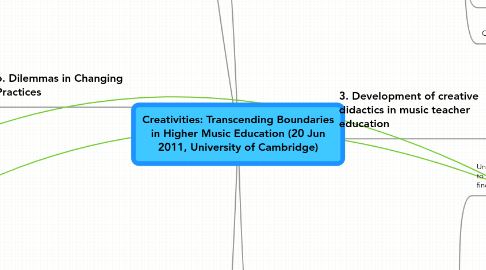
1. 1. What is musical creativity and implication for educators?
1.1. Connoisseurship?
1.2. Matter of Practise or Genetic Endowment?
1.3. Definition and application: Originality, development, performance, potential...
1.4. Application to all arts?
2. 2. Creativity and Originality in performance - report of teaching and learning of creative music-making
2.1. Details of Workshop
2.1.1. Forum
2.1.2. Seminar
2.2. First understanding of performers' experiences of developing an original and creative performances
2.3. Support for fieldwork of observing 1-1 lessons
2.3.1. planning for research strands and actual fieldwork
2.3.1.1. Skills of creativity or originality?
2.3.1.2. Hierarchy of performance goals?
2.3.2. Initial findings: Different aspects of performance creativity... tool box... butterfly
2.3.2.1. Positive reaction of filming/watching
2.3.2.2. Older students more detailed in self-reflections
2.4. Contacts with staff in institutions/raised interest/dialogue
2.5. Administering of Questionnaire
2.5.1. Principal components
2.5.1.1. Creativity and Individuality
2.5.1.1.1. Cannot be learned with some exceptions
2.5.1.1.2. Should be taught well
2.5.1.2. Craftsmanship and dedication
2.5.1.3. Knowledge
2.5.1.4. Coping with challenges
2.6. Challenges
2.6.1. Widely distributed across time/space
2.6.2. Aspects of creativity/originality?
2.7. Opportunities
2.7.1. Communicating aspects of research
3. 5. Horizontal and vertical listening in music educaton
3.1. Challenge of multivoicedness
3.1.1. The lonely teacher
3.2. Challenges in music education: debates from Finland
3.2.1. Relevance?
3.2.2. high cost?
3.2.3. how to facilitate dialogue?
3.3. Musical nature of the reflecting process
3.4. Method of structuring reflection and conversation
3.4.1. "new embodiments of knowledge"
3.4.2. "freedom to pursue ideas"
3.5. Inner and Outer Voices
3.5.1. Polyphony of voices
3.5.2. Paralogy
3.5.3. Talk WITH the person... (and in the process hearing several others)
3.6. Able to think of different ideas (and not so much of seeking consensus)
3.7. Challenges - dissonance, seeking agencies and access
4. 6. Dilemmas in Changing Practices
4.1. Thinking about pedagogy/curriculum and meaningful music-making
4.1.1. Why should creative music-making stop when people leave full-time education?
4.1.2. How do we reward musical achievement?
4.1.3. What do we believe music is for?
4.1.4. What is the prevailing myth of music in our time?
4.2. Quotes: Objects of musical experience vs Experience of Musical objects; visionaries vs entertainers
4.2.1. Music as objects
4.2.1.1. e.g. 'addiction' to notations
4.2.2. Music as experience
4.2.2.1. e.g. 'here and now'
4.3. Lifemusic= project, paradigm, method
4.3.1. Respond to perceived musical needs/main integrity of musical experience through learning process
4.3.2. Lifemusic precepts
4.3.2.1. Non-negotiable (e.g. everyone is musical)
4.3.2.2. Appreciating 'norms'
4.3.3. South East Coast Communities Programme
4.3.3.1. e.g. community-university exchange, recognising/valorising community knowledge
4.3.3.2. Using participatory music to support community
4.3.3.3. "Turn life into soul"
4.3.4. Challenges
4.3.4.1. Valorising previously marginalised activity
4.3.4.2. Community engagement
4.3.4.3. Redefining music knowledge - new epistemology
4.3.4.4. New frameworks for musical performance
4.3.4.5. Developing new assessment tools
4.3.4.6. Questioning cultural assumptions
5. 3. Development of creative didactics in music teacher education
5.1. Risk taking, 'joyfulness', collaborative research
5.2. Mission: plan and organise creativity workshops/courses
5.3. Survey on perspective on creativity, teaching and learning
5.3.1. Can be learnt/taught
5.3.1.1. >94% teachers agree
5.3.1.2. <25% students perceive this?
5.3.2. Creativity is the same for all cultures (???)
5.3.3. Men and women/different ethnic origins creative in the same way (???)
5.3.4. Academic performance vs creativity - is it a wild card?
5.4. First and second generation creativity concepts
5.5. Coming up: Workshops and Reading groups
5.5.1. Themes: Perceptions of creativity, teaching and learning
5.5.1.1. Extract themes that might suggest hindrance of creativity in HE
5.6. Possibilities
5.6.1. But are they used?
6. 4. Digital video as a research tool for creativity in teaching and learning
6.1. Unique approach of outreach to boys and synthesising findings
6.1.1. Requirements of marketing, communications sitting along research questions: what is the potential of the dance to social/personal transformation? What is the space that fosters reflection?
6.2. Detailed analysis of video clips
6.2.1. Quality of conversation/dialogue
6.2.1.1. Personal voice
6.2.2. partnerships/collaborations
6.2.3. Insights to teaching/learning of creativities in outreach context... through participants' voices
6.2.4. Participants' extrapolation/identifying with each other's experiences.
6.3. ASPIRE ('Talk to Learn') Poject: Video project to study teaching/learning experiences
6.3.1. Insightful perspectives
6.3.1.1. Sharable and widely available tools
6.3.2. Strength - capture voices and practices
6.3.3. Support deep learning... developing long term conversation.... what makes learning deep in the school?
6.3.3.1. Insights may take place outside the classroom
6.3.3.2. Technological mediation as a problematic entity does not consider the empathetic benefits it afford.
6.3.3.3. Strike balance - development of protocol
6.3.3.4. Co-construction of meaning by the participants... enter into dialogic space.
